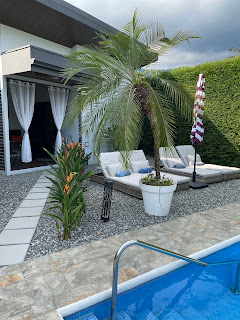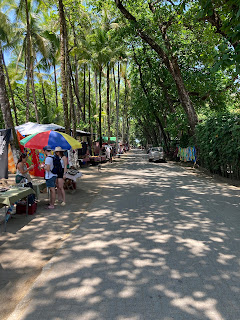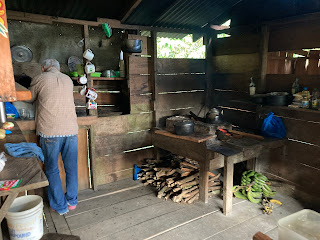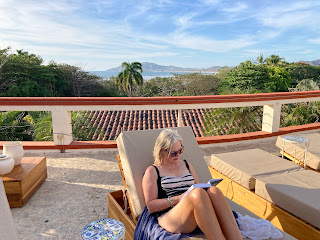We hated to leave the villa, but we moved down the road a few miles to the town of Uvita which borders Marino Ballenas Park and hosts a sizable expatriate population with its amenities. It is still relatively laid back compared to some of the big beach towns along the coast. We stayed in a very nice boutique hotel owned by a couple who just moved from Toronto. We were the only guests for two nights and we ended up having some long conversations with our very kind hosts. We took a couple of trips to the whale’s tail; one at high tide and one at low tide. It is a bit of a surreal experience to stand in the surf as waves come at you from both sides. The tail is composed of a rocky shelf met with crashing waves and tide pools. Staying in an expat community enabled us to enjoy Thai food and an authentic Italian pizzeria with Papa working the earthen wood fire oven. We even got to experience a tropical downpour one evening. It was with mixed emotions that we made our way north to Liberia on our last day; sorry to say goodbye to the beautiful Costa Rican country but a little anxious to get home.
Monday, March 17, 2025
Costa Rica - the southern Pacific coast
Friday, March 14, 2025
Volcanoes, cloud forests and jungle
It was a long, slow, winding drive to La Fortuna; but we enjoyed every bit of it. Seeing the beautiful countryside, towns and local Costa Ricans doing life is an adventure in itself. The last couple of hours of the drive were along the shores of Lake Arenal with views of the cloud shrouded volcano Arenal. Before checking into our hotel, we got the details from the guide company for our overnight trek across the mountains. The town of La Fortuna is the tourist hub of Costa Rica with a much larger European presence than the Pacific beaches. Our hotel had a nice view of the volcano.
We left on our two day hike around noon with our guide Franklin who had lived alone in the mountains for ten years. We weren’t sure about this stout older man in knee high white rubber boots, but he proved to be a knowledgeable mountain stud. So off we went with 2 other Americans 3 Germans and 1 French woman on a 20km hike through the mountains with an overnight stop in a rustic mountain shelter. It wasn’t long before we forded a small river and then started the 3000 ft. climb through tropical forest. Our Camino legs have gone rusty, and we lagged a little behind the younger crowd. Our guide filled us in with forest information: natural insect repellent, edible termites and plants. The shelter was even more rustic than we envisioned; wooden bunks with thin foam and old soiled sleeping bags and pillows. We even had a huge hole in the floor with bare earth and who knows what else lurking underneath the shelter. The candlelight dinner was cooked on a traditional wood stove by our 75 year old host. His two dogs kept the wild animals at bay all night long with barking. Of the ten hours that we laid on our hard bunk, we maybe got four hours of sleep. The next morning we absorbed the amazing view of volcano and surrounding mountains and tanked up on beans, rice and eggs for some more hiking. The camaraderie with the others reminded of nights on the Camino. The rest of the hike took us to ridges and open meadows with fantastic views and into the cloud forest of Monteverde and the town of Santa Elena. The hardest part of the trip was the 4 hour impossibly bumpy van ride back to La Fortuna.
The next morning, before leaving the area, we took a hike through a forested park with swinging bridges. We enjoyed the leisurely stroll through the amazing forest. Then we drove six hours through the highlands and down the southern coast to the famed Manuel Antonio National Park. Getting a mandatory online ticket to a guided tour proved quite taxing. With much anticipation we entered the park which made TSA entry look like a breeze. However, the experience was very disappointing. Throngs of tourist bumping into each other, trying to look through their guides telescope at a tiny lizard or camouflaged bird soon got old. We did see a few monkeys and some balls of fur real high in the trees that were supposed to be sloths. The picturesque twin beaches were packed with people and the only eating was allowed in a large cage. For the record, we don’t recommend Manuel Antonio Park; it is overhyped.
Sunday, March 09, 2025
Costa Rica - Nicoya Peninsula
We arrived in Liberia, Costa Rica about twelve hours later than scheduled. Our Alaska flight from Seattle landed on time in LAX but sat on the tarmac for an hour waiting for an empty gate. We consequently missed our flight to Liberia. Instead, we caught the red eye that night. Alaska Airlines did put us up in a hotel for the afternoon, so we got a little rest after canceling a hotel and rescheduling our car rental. As it turned out, we were able to transition to Costa Rica better In the morning light. Our original scheduled flight would have necessitated renting a car and finding our beach hotel 30 miles away in the dark in a strange new environment. Instead we were able to rent the car, go to the city, get some supplies and a Costa Rican SIM card and make it out to our hotel by 11am and checked in early.
Our first day was spent in Playa del Coco. The small town has a mixture of northern retirees, along with local and international tourists. The bay was filled with anchored excursion boats; and while we walked the beach, we watched tourists clumsily board small boats in the surf. A tropical sunset and beach side dinning topped off our first Costa Rican day. The next day we beach hopped, stopping for a quick stroll and photos at each one. Hermosa, Flamingo and Conchal beaches all had a different feel. Our favorite was Conchal with its white shell ‘sand’. Our hotel in Tamarindo was very nice. It was a Best Western, but nothing like a US BW. It was more like a luxurious beach hotel with an economy price. We enjoyed cooling off in the pool and some relaxed reading. The town and beach in Tamarindo was bustling with tourists from around the world. We walked by a lot of fancy restaurants and boutiques to a crowded night market and ate paella on a paper plate standing by the street. A balmy beach walk in the dark brought us back to our hotel.
The Nicoya Peninsula is one of five ‘blue zones’ in the world. (highest percentage of centenarians) We are hoping to catch the vibe! The beach towns on the southern part of the Nicoya Peninsula are remote and hard to access, and the Waze directional app didn’t want to cooperate with our desire to stay on the coast. Consequently, we spent hours back tracking roads as we visited Samara and then on to Santa Teresa. We saw a lot of beautiful country, rural backroads, small towns and jungled hills. We arrived in Santa Teresa for our two night stay at a boutique hotel between the busy street and the beach. Santa Teresa is a unique tourist destination. The main street is a third world dusty rutted dirt road with open drainage, lined with expensive restaurants and boutiques. The traffic is comprised of gen Z tourists on noisy rented motorcycles and four wheelers with surf boards attached. Pedestrians have to jockey there way over ditches beside rushing traffic. We walked five miles on the sandy beaches dotted with occasional rocks and a sea stack. Surfers and their groupies permeate the beach, but private sections could still be found. We spent a full day in Santa Teresa, walking, swimming and lounging. On Sunday we headed to the mountains for new adventures but stopped in Montezuma for breakfast. This small beach community has a hippie feel. The rocky coast must keep the surfers away!

































